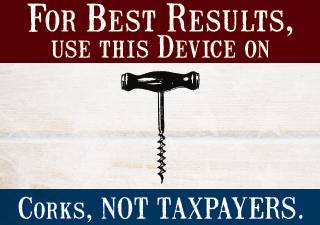Media
Top-5 Liquor Liberty Myths Busted!
 Pennsylvanians have come together, transcending party lines, gender, economic means and all geographic regions of the state to call for an end to the state-run monopoly on wine and spirits.
Pennsylvanians have come together, transcending party lines, gender, economic means and all geographic regions of the state to call for an end to the state-run monopoly on wine and spirits.
But will legislators listen?
During yesterday’s floor discussion on an amendment to House Bill 11 that would end the government-run monopoly, many half-truths and myths were used against privatization.
Here are the top-5 myths from last night’s debate:
1. State-run liquor stores are a cash cow for taxpayers.
- The Pennsylvania Liquor Control Board (PLCB) is losing money. The PLCB ended the 2011 fiscal year with negative $31 million in net assets, having lost $23 million in 2010-11. Guess who’s responsible for paying off those liabilities?
- Every dollar the PLCB collects comes from taxpayers and consumers. More than 80 percent of the annual liquor store “profits” are generated from taxes on buyers. The rest comes from the standard “markup” the PLCB puts on every bottle they sell. Truth is: Privately-owned liquor stores would collect the same taxes.
2. Private companies selling alcohol is unsafe.
- Despite the highest level of government control in the nation, Pennsylvania ranks higher than the national average in rates of underage drinking, underage binge drinking and overall binge drinking. The commonwealth also ranks higher than most border states in alcohol-related traffic fatalities and total alcohol-related deaths per capita.
- The claim that the U.S. Centers for Disease Control task force provides strong evidence that privatization of liquor sales is dangerous is disingenuous at best. The “CDC study” is only a preliminary recommendation, and has not been “peer reviewed.” In fact, none of the 21 studies the task force looked at showed privatization increased DUIs, alcohol-related deaths, or underage drinking.
3. The state-run stores are efficient.
- The PLCB has created countless business bureaucratic boondoggles, but we managed to narrow it down to the top ten most egregious episodes of incompetence.
4. Privatization leads to higher costs and less selection.
- The PLCB’s own analysis found that 45 percent of drinkers would rather break the law and bootleg their wine and liquor across the borders to get better prices and selection in neighboring states.
- The Commonwealth Foundation compared wine and spirits prices from stores in all six states bordering Pennsylvania, comparing the PLCB’s top 10 best-selling items in each price category. Average wine prices were lower in all six border states, from an average of 20 percent lower in Maryland to 3 percent lower in New Jersey. Average spirits prices were lower in Ohio, Delaware, and Maryland, but higher in West Virginia, New Jersey, and New York.
5. Border bleed is an insignificant loss to Pennsylvania.
- In a taxpayer-funded, PLCB-commissioned study, a Neiman Group survey showed that 45 percent of residents in Philadelphia and its surrounding counties purchase some or all of their alcohol outside of Pennsylvania, even though it is illegal to transport it back into the state. Over time, Pennsylvania businesses and taxpayers have lost billions in sales and tax revenue to bordering states.
But hey, let’s just keep the system in place, right? It’s so much better to turn your citizens into Prohibition-era bootleggers in pursuit of an otherwise legal commodity than it is to embrace free markets, create new jobs and let freedom drink.
Click here to let your legislators know the truth about liquor liberty.